Japan Wood Products
Prices
Dollar Exchange Rates of
10th July 2015
Japan Yen 122.78
Reports From Japan
Consumer confidence rebounds
Results of the June consumer confidence survey were
released by the Cabinet Office on 10 July. Consumer
sentiment improved in June after the decline reported for
May.

The overall consumer confidence index rose to 41.7 in
June and sentiment in all sub-sectors in the survey were
positive. The June survey reveals that most respondents
expect prices to go up in the next twelve months which
will hearten the Bank of Japan which has set an ambitious
inflation target.
For the full details see:
http://www.esri.cao.go.jp/en/stat/shouhi/shouhi-e.html
Caution on US interest rate rise pushes up yen
The yen rose against the US dollar mid-month after the US
Federal Reserve signaled its caution on raising interest
rates in the short term.
The US Federal reserve expressed concern about the pace
of growth in major economies, specifically in China, as
well as its concern on the Greek debt crisis. At one point
in early July the yen rose to 120 to the US dollar the
strongest for almost three months.
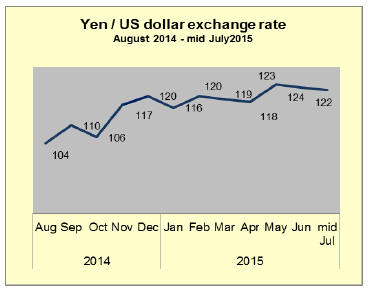
Manufacturers continue to increase capital spending
While the total value of May machinery orders by
Japanese manufacturers fell from the previous month,
core machinery orders unexpectedly rose marking three
monthly increases. The rise in core orders, a data series
regarded as an indicator of capital spending, beat
expectations.
May housing starts rise year-on-year but prospects
uncertain as orders fall
Housing start data for May released by the Ministry of
Land, Infrastructure, Transport and Tourism showed an
increase in May 2015 compared to May 2014 marking the
third consecutive year-on-year rise.
May 2015 housing starts grew by around 6% year-on-year
improving on the pace of improvement in April. However,
compared to levels in April this year, starts were down
about 5%.
Construction companies report orders received for the
ministry’s survey and have indicated orders fell just over
7% in May following the 12% fall in orders in April.
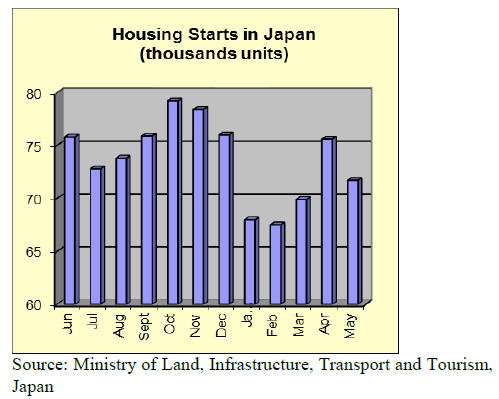
Import round up
Doors
Japan’s May imports of wooden doors fell 4% from the
previous month and were down around 5% year on year in
May. Average imports in the first five months of 2015
were down 17% compared to the first five months of 2014.
China, Philippines and the USA continue to be the main
suppliers accounting for more than 80% of total wooden
door imports.
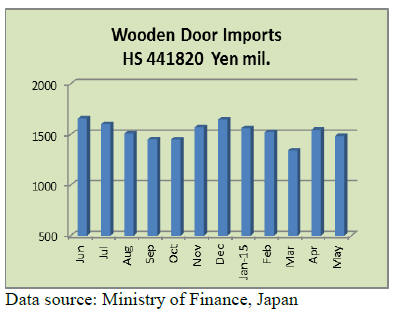
Windows
Wooden window imports by Japan in May 2015 were
down sharply year on year (-21%) and compared to the
previous month, May imports were down 4%. The modest
month on month fall disguises the massive 29% drop in
average monthly imports in the first five months of 2015
compared to the same period in 2014.

Assembled flooring
Imports of assembled flooring have increased for three
consecutive months and May imports were a massive 56%
above those a month earlier. However, May 2015 imports
were down 10 from the same month in 2014.
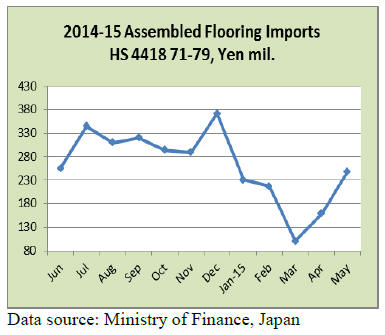
In spite of the impressive upward trend in imports of
assembled flooring in 2015, especially over the past two
months, average imports for the first five months of 2015
were down 25% on the same period in 2014.
Plywood
All three major suppliers of plywood to Japan saw a
decline in business in May. Total plywood imports in May
fell 32% year on year and compared to the previous month
May imports were down12%. The big loser was China
were year on year imports in May were down around 35%.
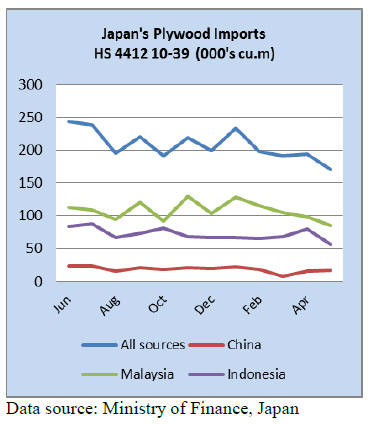 
Both Malaysia and Indonesia also saw business with Japan
slide as plywood imports by Japan from each country fell
20% in May 2015. First five month average imports in
2015 were 25% less than in the first five months of 2014.
Trade news from the Japan Lumber Reports (JLR)
For the JLR report please see:
http://www.nmokuzai.
com/modules/general/index.php?id=7
Progressive depreciation of the yen
Spiraling cost by thirteen years’ low of the yen. With
outlook of early increase of interest rate of the U.S. dollar
by improvement of employment statistics, U.S. dollar has
been strengthening to all the other currencies and the yen
dropped down to close to 126 yen to the dollar, which is
the lowest since June 2002.
The yen shot up to less than 80 yen to the dollar in fall of
2012. After having marked record high, the yen has been
falling to the U.S. dollar and Euro for last two years.
Although there was momentary demand pick-up before the
consumption tax increase since April 2014, cost of
imported building materials has been climbing and transfer
to the sales prices faces tough going by weak demand.
Particularly since middle of last year, the reactionary drop
of the demand was conspicuous so the importers and
wholesalers suffer chronic loss.
Higher cost of imported materials continues but price
increase related to the cost is difficult in demand
depressed market. It is uncertain if depreciation of the yen
would tighten the market or reduce suppliers’ export
prices to ease higher yen cost. This would influence future
supply of imported materials in slump market.
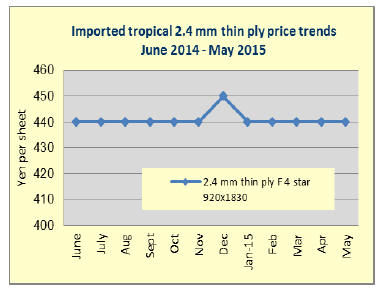 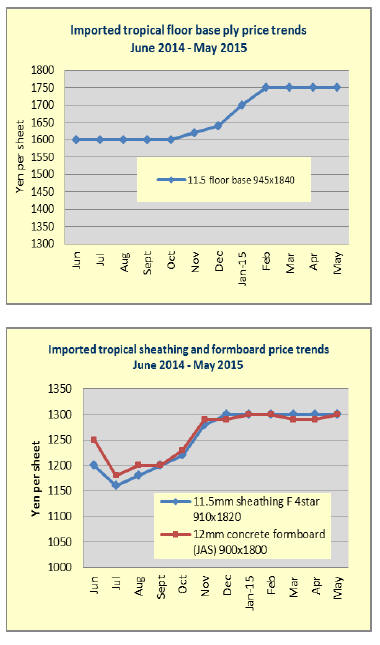
JLIA’s to maintain focus on securing verified legal
wood products
The Japan Lumber Importers Association held the general
meeting and elected Mr. Satoru Yasuda for the new
chairman of the Association.
The new chairman commented that the Association would
make every effort to have balanced steady supply of
imported wood materials by having friendly relationship
with overseas related groups with close communications to
have smooth trade. Also it is now important to pay
attention to domestic wood supply.
Mr. Yasuda is currently managing director of Sojitz
Building Materials Corporation. Mr. Yasuda is 57 years
old, who was working for former Nissho-Iwai
Corporation. Focus of this term is to maintain
authorization system of legal wood use and continue
asking overseas wood products suppliers to supply legally
certified products and the Association will lead market to
use legally certified wood products.
In fiscal year of 2014, a percentage of imported legally
certified sustained yield wood by the members of the
Association was 69.9%, 2.7 points up from the previous
year, out of which 26.2% was sold as certified wood, 4.5
points up.
As to communication with overseas groups, the
Association joins the Canada Wood seminar in June held
by COFI as joint planner. Then in September, it will hold
plywood conference in Tokyo by three countries, Japan,
Malaysia and Indonesia. It will continue information
exchange with Russian and European related groups.
The Association made outlook of imported wood products
in 2015. It shows decrease of import on both logs and
lumber. Log import will decline by 9.5% and lumber by
6.9%. Russian log volume will be less than 200 M cbms
while North American lumber will increase by 2%.
European lumber import will drop by nearly 20% due
toimport adjustment in the first half of the year.
Seihoku group stops plywood production
Softwood plywood market has been in slump with weak
demand then the supply has been more than the shipment
so that the inventories have been swelling. In this supply
glut, the market continues weakening so the major
manufacturer, Seihoku group, which has more than 50%
share in softwood plywood market, announced to reduce
the production to restore the market.
April softwood plywood inventories were 256 M cbms,
2.3 times more than April of last year and the market
prices of 12 mm 3x6 panel prices are down to 700 yen per
sheet delivered or less from 850 yen in early January and
the prices have not bottomed out in June yet.
The Seihoku group now decided to reduce the production
by 30% and shift the product from structural panel to nonstructural
panel like concrete forming panel. Concretely, it
will reduce production of structural panel by 30% so that
by the time fall demand shows up after three months, the
supply should balance out and the price should recover.
The president Inoue says that unless plywood market is
stabilized, stable supply of local logs with certain level of
prices would become difficult, which hampers
revitalization of forest resources. Another measure is to
change product mix from heavy percentage of structural
panel to non-structural panel.
In the past, concrete forming panel and floor base panel
have been mainly South Sea imported hardwood plywood,
which would be about 100,000 cbms a month. This is
equivalent to five million sheets of 3x6 12 mm panel. If
softwood panels can replace this market, this would
become a great help for softwood plywood. It needs
technical improvement but it is necessary to solve the
problems to change product mix.
Daiwa House starts housing in Malaysia
Daiwa House Industry Co., Ltd (Osaka) concluded an
agreement to develop and market prefabricated detached
units with the largest developer in Malaysia, Sunway SDN
BHD on June 11 and established a joint venture company,
Daiwa Sunway Development SDN BHD, (DSD).
Malaysia.
DSD will start building 100 detached houses in 5.3
hectare’s property of Sunway Iskandar project since
summer of 2015. Daiwa House has built seven Japanese
plants in Malaysia since 1964 then opened Kuala Lumpur
representative office in 2012 and has studied industrialised
housing to match tropical rain forest climate of Malaysia.
In 2013, it put up Malaysian type experimental light steel
prefabricated unit in Sunway Eastwood property for sale
in lots, which is in Selangor province near Kuala Lumpur.
This completed in March 2014.
‘South Sea’ (tropical) logs
Weather in Sarawak has been good since rainy season was
over but because of tight control of illegal harvesting log
production has been low.
Log export prices have stayed up high. Meranti regular
prices are firm at US$290-295 per cbm FOB. Small
meranti prices are US$260-265 and meranti low grade for
India are up at US$270-280.
Keruing regular are US$420-430 and kapur regular are
US$410-420. They are up by US$10 from May. With slow
production, quality logs are scarce but the prices keep
climbing on all the grades.
Unlike Chinese buyers, who buy any kind of species for
the volume, Indian buyers are choosy and select hardwood
like kapur and keruing but it becomes hard to have enough
volume of these species in Sarawak and Sabah so they are
sending more ships to PNG and Solomon Islands.
China has been slowing their purchase then India is filling
a gap but log production in PNG is dropping. In Solomon
Island, for last two weeks, heavy rain hinders log
production.
Domestic logs and lumber
In general, by increasing log production and weak lumber
market, log prices are falling across the board
all over Japan. In some areas, with strong demand of low
grade logs for biomass generation, log prices were high
but now the supply is fully satisfied and the prices are
softening.
Asahi Woodtec changes base raw material mix
Asahi Woodtec Corporation (Osaka), building materials
manufacturer, announced change of base materials mix of
floor board.
In the past, a percentage of imported materials such as
plywood and domestic materials such as particleboard was
nine to one. It will change it to three to one so domestic
share is 2.5 times more to stabilize cost of base materials
of flooring.
The company manufactures and markets floor products of
about 792,000 square meters a month. Floor base materials
have been 75% of South Sea hardwood plywood like
meranti, 15% of plantation wood like falcate and 10% of
domestic products like particleboard.
Looking at recent trend of South Sea hardwood plywood,
decline of supply of virgin timber, tight control of illegal
harvest and chronic high export price of plywood
continues so future outlook is very severe for stable supply
and price then came recent weakening of the yen, which
pushes cost of imported materials so fundamental issue is
to shift from imported tropical hardwood products to
others since passing higher cost to the floor customers is
difficult.
Now it decided to change mix of base materials to 50%
meranti plywood, 25% of plantation wood plywood,
making total percentage of 75% of plywood then 25% of
domestic products like particleboard.
|